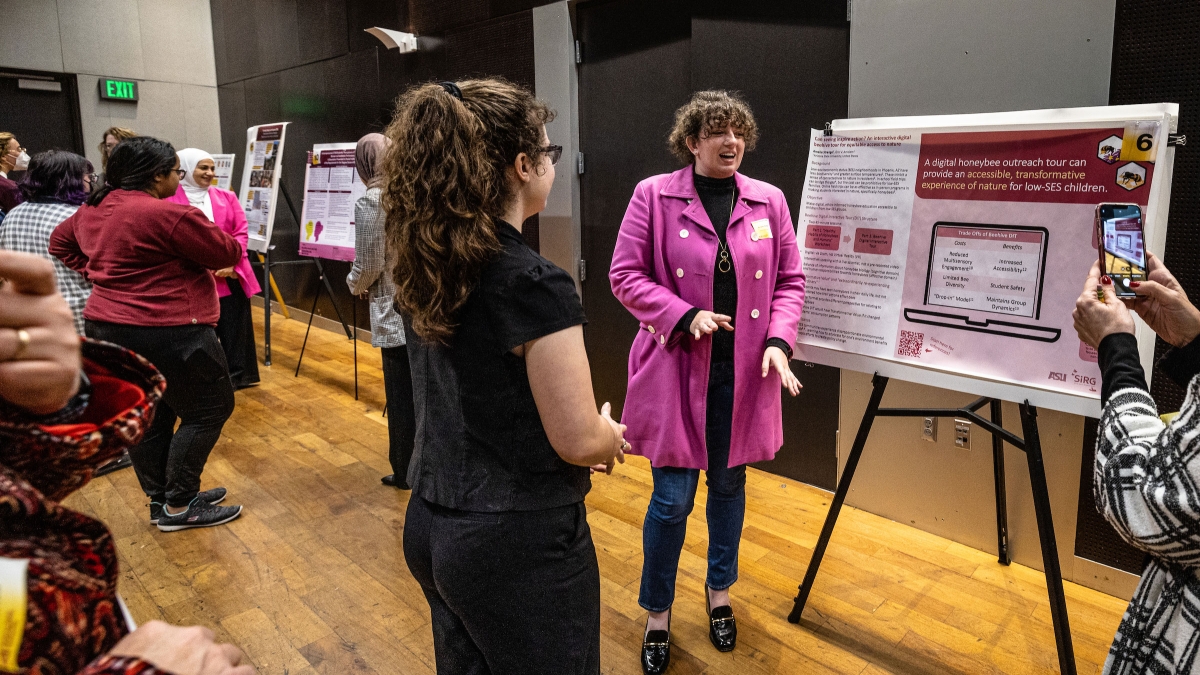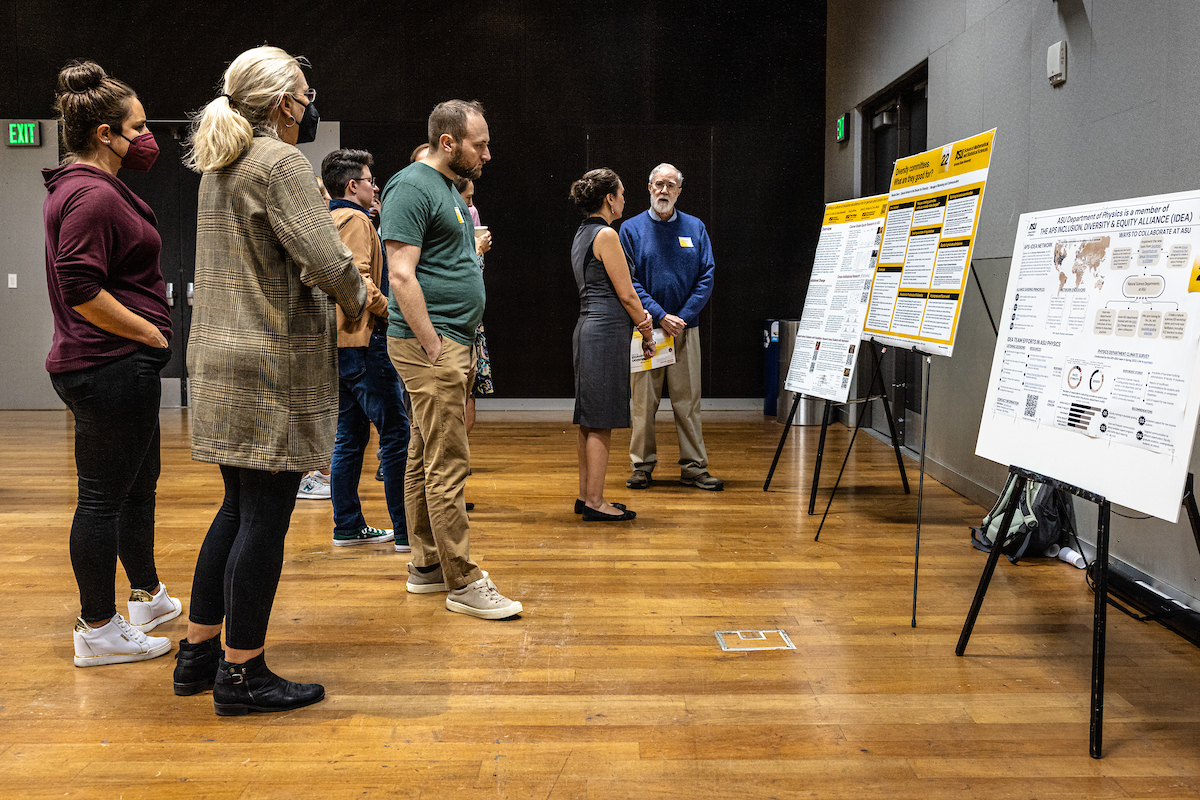Kristen Parrish opened last week's Natural Sciences Inclusion Summit 2022 with words that set the stage for the daylong event.
“It’s all about connections,” said the associate director of the Research for Inclusive STEM Education (RISE) Center at Arizona State University.
The summit, which took place Nov. 9 at ASU's Memorial Union, brought together 19 speakers from the university community to discuss current research that identifies and addresses inequities in STEM education. The event was hosted by The College of LIberal Arts and Sciences and the RISE Center.
“The point of today is to walk away with more connections and identify ways that we can work together and support one another,” Parrish said. “That is the goal of our session.”
With nearly 300 people participating both online and in person, there was a good chance of reaching that goal.
Sara Brownell, director of the RISE Center and an organizer of the event, was thrilled with the turnout.
After two years of online programming, “we wanted to really give people the opportunity to come together and build community,” said Brownell, who is also an education researcher and teaches undergraduate biology at ASU.
The theme of inclusiveness permeated the entire day. In addition to deans and university leaders, organizers intentionally included a range of professors, faculty members and students from various backgrounds to deliver the 10-minute, lightning-style talks.
“We were really intentional about the talks,” Brownell said. “We wanted to make sure that multiple voices were heard, not just across disciplines but also in terms of position.”
Including more students
Lisa Magana started the day celebrating a major milestone — ASU’s recent distinction by the U.S. Department of Education as a Hispanic-Serving Institution (HSI). That recognition means at least 25% of the full-time undergraduate students enrolled at ASU are Hispanic.
“This is a really big deal for ASU,” said Magana, associate dean of diversity, equity and inclusion for The College. “And it’s not just the demographics. It’s the policies and nationally recognized programs that support the retention and graduation of Latino students.”
“What can we do to create a more inclusive future for the academic enterprise?” asked Kenro Kusumi, dean of natural sciences, as the summit began. “What kind of methods of instruction can we use to reach more learners and a broader and more diverse set of learners?
“That’s what we want to know today. We’re all very engaged in research and activities to create an environment that is inclusive — where everyone can thrive.”
Research, results and more
Nearly every talk had some element of interactivity to it — allowing participants to be more engaged in the summit and connected with others.
During one talk, PhD student Carly Busch talked about her research on the diversity of identities. Busch said that when professors — particularly those from stigmatized communities — reveal what may be described as their unseen identity, they can play a powerful role in making students with similar identities feel more comfortable and connected.
Other talks touched on reaching and retaining online students.
Julie Greenwood discussed the unique academic challenges online students face and how systems such as InScribe, which empowers students by connecting them to the answers, resources and people they need to succeed, can help.
“We have learning assistance in the community almost 24/7,” said Greenwood, vice dean for educational initiatives at EdPlus, which works to increase student success and reduce barriers to achievement. “There's always someone there who can help support them.”
During the lunch poster session, the Memorial Union's Arizona Ballroom was buzzing as attendees spoke to 23 researchers about their poster presentations.
A few examples:
- PhD student Baylee Edwards explored the experiences of Christian students in undergraduate biology classes.
- PhD student Amalie Strange's presentation focused on a digital interactive beehive tour for low income students “to experience a connection with honeybees.”
- ASU Instructor Ally Hamie’s poster presentation was on how faculty members’ perceptions of students — particularly underrepresented minority students — can have a direct impact on their direction in STEM programs. “There really is science behind this,” Hamie said.
Summit attendees look at posters showing undergraduate and graduate students' research at the Natural Sciences Inclusion Summit 2022, on Nov. 9, in the Memorial Union. Photo by Charlie Leight/ASU News
A future of increased inclusion
Executive Vice President and University Provost Nancy Gonzales wrapped up the discussions of the day.
“I believe our ability to diversify the sciences and focus on equity and inclusion is actually fundamental to addressing some of the challenges we’re seeing in higher education today,” she said.
Gonzales discussed the university's initiatives related to Indigenioius, Black and online students, and reflected on the univeristy's new HSI status and the increase in first-generation and Pell Grant-eligible students.
“If you look across the board, we’ve made tremendous gains in increasing the diversity of our students to more closely match the diversity of our state,” Gonzales said.
She said ASU plans for continued success and that summit researchers will play a part in those plans.
“Ultimately, the goal is to go beyond special programs to inclusion for all students in scalable ways,” she said. “We are trying to really examine everything we are doing and we really need the ideas you are developing to bring into our redesign process.”
Top photo: PhD student Amalie Strange presents her research on equitable access to nature during last week's Natural Sciences Inclusion Summit 2022. Photo by Charlie Leight/ASU News
More Science and technology

ASU to host 2 new 51 Pegasi b Fellows, cementing leadership in exoplanet research
Arizona State University continues its rapid rise in planetary astronomy, welcoming two new 51 Pegasi b Fellows to its exoplanet research team in fall 2025. The Heising-Simons Foundation awarded the…

ASU students win big at homeland security design challenge
By Cynthia GerberArizona State University students took home five prizes — including two first-place victories — from this year’s Designing Actionable Solutions for a Secure Homeland student design…

Swarm science: Oral bacteria move in waves to spread and survive
Swarming behaviors appear everywhere in nature — from schools of fish darting in synchrony to locusts sweeping across landscapes in coordinated waves. On winter evenings, just before dusk, hundreds…



